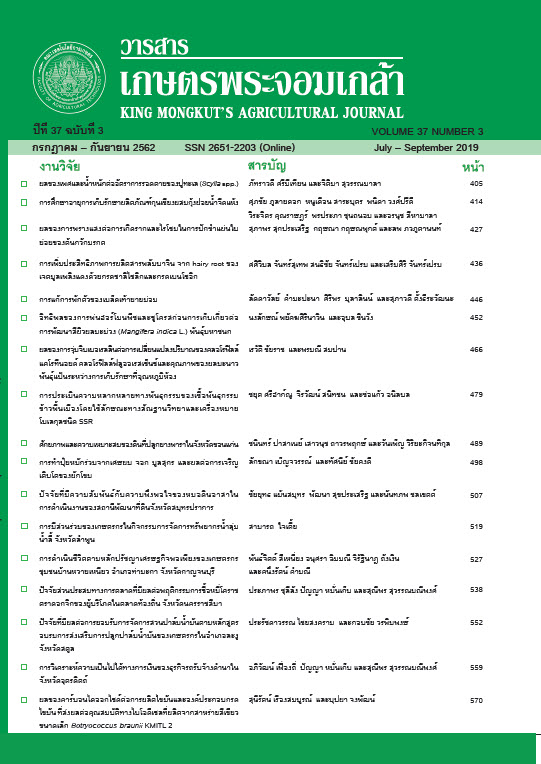Effect of Shading on Rooting and Rhizome Formation of ZZ plant Leaflet Cuttings
Main Article Content
Abstract
Light is an important factor for rooting and root development of cuttings. But sunlight during
summer season in Thailand has high light intensity that is detrimental to rooting of cuttings. Effect of black
plastic net shading on rooting and rhizome formation of leaflet cuttings of ZZ plant during propagation in
peat moss was studied. Cuttings were placed under a lath-house condition with plastic roof for rain
protection and average midday light intensity of 846.0 μ mol.m-2.s-1. Plastic net shading reduced the
average midday light intensity down to 473.2 μ mol.m-2.s-1, reduced maximum middy temperature by 5°C
and increased relative humidity in the propagation facility about 8 – 13%. After propagation for 60 days,
it was found that all leaflet cuttings formed adventitious roots and each cutting had 1 small rhizome.
Shaded cuttings had fewer numbers of new roots but shading did not affect root length and rhizome size.
All rooted leaflets were transplanted into a 4-inch plastic pot and placed in the same environmental
conditions for further growth monitoring of a new shoot. At 4 months after planting (MAP), only 20%
of leaflet cuttings in both light conditions formed a new shoot. The new shoots varied in size; short shoots
with only 2 leaflets per shoot and longer shoots with 4 – 6 leaflets per shoot. Shaded cuttings had less
number of leaflets per new shoot. At 8 MAP, number of cuttings from both light conditions that formed
a new shoot increased similarly to 84.4%. Both light conditions did not affect new shoot length and
number of leaflets per shoot. Therefore, shading of ZZ plant leaflet cuttings during propagation in peat
moss under a lath-house condition with plastic roof for rain protection did not improve their rooting and
rhizome formation.
Article Details
King Mongkut's Agricultural Journal
References
ใบของกวักมรกต. ว. วิทยาศาสตร์และเทคโนโลยี มหาวิทยาลัยเกษตรศาสตร์. 3: 17 – 25.
Blanchard, M. G. and R.G. Lopez. 2007. ZZ plant is an easy choice for tough indoor use. Greenhouse Production and
Management Magazine (January): 50 – 56.
Chen, J. and R. J. Henny. 2003. ZZ: A unique tropical ornamental foliage plant. HortTech. 13: 458 – 462.
Chen, J., R. J. Henny and D. B. McConnell. 2004. Cultural guidelines for commercial production of interiorscape ZZ
(Zamioculcas zamiifolia). Document no. ENH997. Environmental Horticulture Department, Florida Cooperative
Extension Service, Institute of Food and Agricultural Sciences, University of Florida, 3 p.
Cutter, E.G. 1962. Regeneration in Zamioculcas: an experimental study. Annals Bot. 26: 55 – 70.
Elad, Y., Y. Messika, M. Brand, D . R. David and A. Sztejnberg. 2007. Effect of colored shade nets on pepper powdery
mildew (Leveillula taurica). Phytoparasitica 35: 285 – 299.
Healey, K. D., K. G. Rickert, G. L. Hammer and M. P. Bange. 1998. Radiation use efficiency increases when the diffuse
component of incident radiation is enhanced under shade. Aust. J. Agr. Res. 49: 665 – 672.
Lopez, R. G., M. G. Blanchard and E. S. Runkle. 2009. Propagation and production of Zamioculcas zamiifolia. Acta Hort.
813: 559 – 564.
Runkle, E. 2016. Managing light to improve rooting of cuttings. Greenhouse Production and Management Magazine
(September): 62.
Stamps, R. H. 2009. Use of colored shade netting in horticulture. HortSci. 44: 239 – 241.
Svenson, S. E. and F. T. Davies, Jr. 1990. Relation of photosynthesis, growth and rooting during poinsettia propagation.
Proc. Fla. State Hort. Soc. 103: 174 – 176.
Tombesi, S., A. Palliotti, S. Poni and D. Fallinelli. 2015. Influence of light and shoot development stage on leaf
photosynthesis and carbohydrate status during the adventitious root formation in cuttings of Corylus avellana L.Front.
Plant Sci. 6: 1 – 13.


